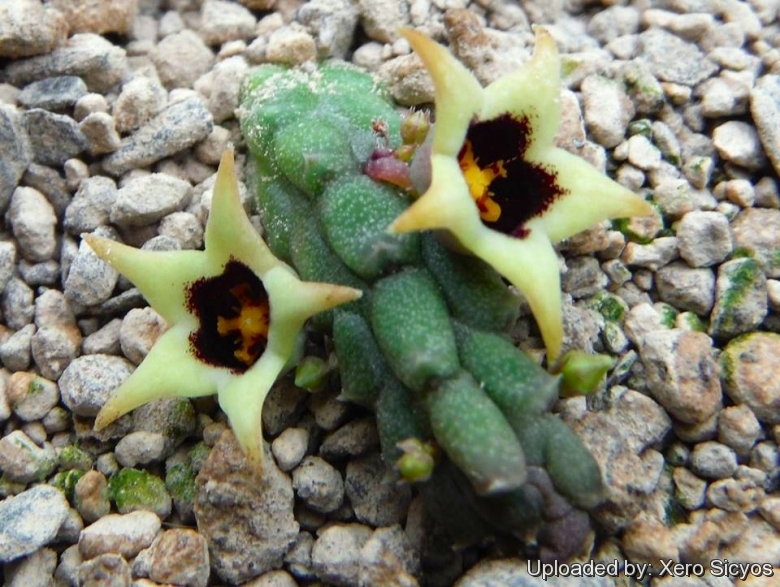
Pectinaria arcuata (Ophionella arcuata) Photo by: Xero Sicyos
Description: Ophionella arcuataSN|34347]]SN|34347]] is an extraordinary miniature stapelia with snakelike shoots that ends their growth underground. No other stapelia is known which seems to invariably finish the growth of its aerial shoots underground, as this one always does. O. arcuata forms dense mats of sinuous stems that are constantly seeking to bury their tips below ground. The flowers are normally caged (the narrow corolla lobes joined at the tips), but occasionally the tips are free. The outside of the flower is smooth, pinkish-cream, the inner surface is cream, maroon in the tube.
Stems: Succulent, almost cylindrical, little branched, with colourless latex, 5-25 cm long, 3-10 mm thick, prostrate, arching-procumbent, partly buried with the tips of exposed stems re-entering the ground, sometimes rising again to the surface, but always finishing their growth underground, forming loops 12-25 mm high, glabrous, green to greenish brown, not glaucous, flowering along the sides or under the loops. Ribs 4 very obtuse, with slightly flattened sides, somewhat tessellately tuberculate along the angles, with the tubercles varying from scarcely prominent to 1.5 mm long, with small teeth near the apex, stipules absent. Rhizomes present, with fibrous roots.
Leaves: Persistent, reduced to tiny, sessile scales, growing horizontal or slightly recurved, 0.5 mm long, triangular with a sharp tip.
Flowers: 1-2(-5) in a fascicle, extra-axillary, usually 1-2 at a time, 4-14 mm long, tubular simple and subsessile. Pedicels 2-3 mm long, glabrous, green. Sepals 2 mm long, ovate, subulate-acuminate, recurved at the tips, glabrous. Corolla in general outline acuminate from a short ovoid base, glabrous and smooth outside and within; tube 3-4 mm long, 3 mm in diameter, cup-shaped or ± ovoid, straw-coloured or pale yellowish outside, dark purple within, the dark colour divided to half-way down into 5 ovate lobes or rounded crenations extending up the base of the lobes. Lobes 5-8 mm long, 2-2.5 mm broad at the base, lanceolate, thence gradually tapering to the acute connate tips, bent upwards and inwards, tips joined (occasionally divergent), but separating so as to form narrow lanceolate openings between them, pinkish or pale purple-tinted on the back, creamy-white, spotted with purple at the tips on the inner face, not ciliate. Corona in two series, but outer and inner corona-lobes apparently in one series, bright yellow, with the 5 lobes alternating with the anthers (outer corona) minute, scarcely 0.5 mm long, deltoid, acute, spreading towards the prominent, knobbled suberect projections behind the inner lobes, the other 5 (inner corona) 1 mm long, more than 0.5 mm broad and almost as thick, erect, subclavate-oblong, very obtuse or subtruncate, incumbent on the anthers, scarcely exceeding the level of the anthers, with their rounded backs projecting like 5 stout ribs beyond the outer lobes.
Fruits (follicles): 25-45 mm long, 3-4 mm thick, paired, glabrous, longitudinally striped with purple and diverging at 30-60°
Seeds: About 15-20 per follicle, 2.5-3.5 mm long, 1.5-2.0 mm wide, pear-shaped
in outline, flat, shiny, smooth and brown. The coma (tuft of hairs) with individual hairs 5-6 mm long.
Chromosome number: 2n = 22
Bibliography: Major references and further lectures
1) N. E. Brown “Flora Capensis”, Vol 4 1909
2) Bruyns, P.V. 1999. “A systematic assessment of Ophionella (Apocynaceae; Asclepiadoideae; Stapelieae)” Bot. J. Linn. Soc. 131: 383–398
3) Bruyns, P. V. 2005. “Stapeliads of Southern Africa and Madagascar”, vol. 1: 234-235.
4) Bruyns, P.V. {Cactus and Succulent Journal of Great Britain 43(2–3): 70. 1981.
5) Focke Albers, Ulrich Meve “Illustrated Handbook of Succulent Plants: Asclepiadaceae: Asclepiadaceae”, Volume 4 Springer Science & Business Media, 2002
6) Doreen Court “Succulent Flora of Southern Africa” CRC Press, 01 June 2000
7) White AC, Sloane BL. 1937. “The Stapelieae”. Ed. 2. San Encino, California: Abbey Press.











